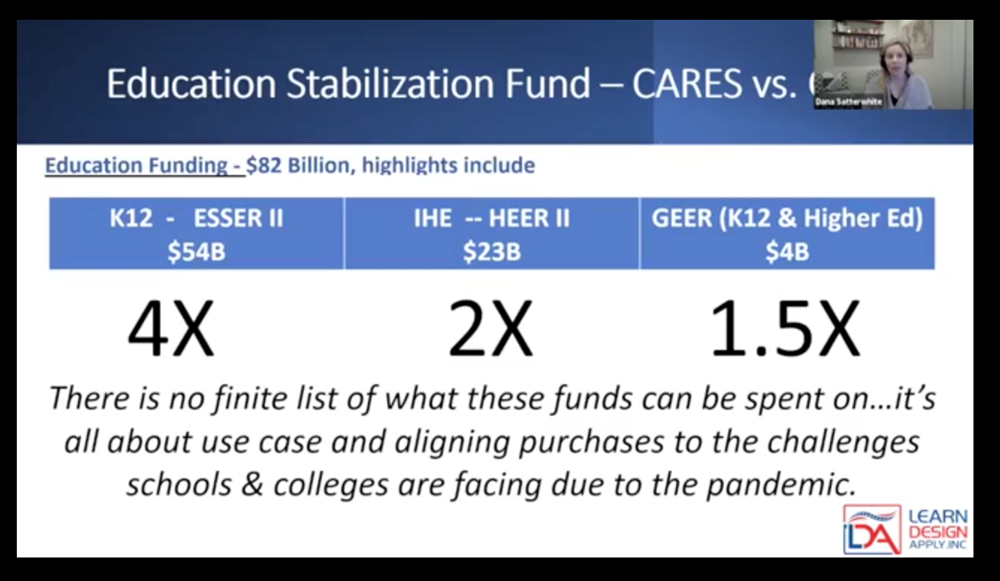The pandemic greatly impacted the education community and forced school districts and institutions of higher education to quickly respond to the changing needs of their students and staff as the standard teaching and learning model drastically shifted. The CARES Act was the first of the COVID-19 relief acts passed to help institutions continue their operations and move to remote learning. “Since the beginning of the pandemic, we’ve seen a total of three relief acts passed; the CARES Act being the first of those three,” explains Dana Satterwhite, Grants Manager, Learn Design Apply, Inc. “The funding under the CARES Act was intended to help all of our public sector entities and institutions of learning navigate the early days of the pandemic and still be able to remain connected in supporting the communities that they serve.”
The sudden onset of COVID immediately revealed technology gaps for several organizations. When institutions received their first wave of relief funding, many schools scrambled to buy webcams, tablets, and other devices to meet the demand of online education. Now, as time has passed, institutions are looking at technology and the flexible learning space model more strategically. “Rather than just the devices and webcams that we saw in the beginning, we’re seeing full classroom integration,” says Satterwhite. “Classrooms want the ability to successfully accommodate in-person and remote learners simultaneously. In addition, there are many initiatives focused on regional economic and workforce development to help find innovative ways to train the next generation.”
Allocating Relief Funds
While relief funds were often used for supplying technology and equipment to teachers and students, some institutions invested in high tech classroom technology, cybersecurity, professional development, and hiring curriculum and instructional designers to strategically look at the future of their learning spaces. “We have seen a lot of out-of-the-box thinking with allocating relief funds,” says Satterwhite. “For example, one district wanted to improve broadband in their area and needed a backhoe to build the trench for the fiber. They were able to use their funds for the necessary equipment to expand connectivity. Another community has been approved to install an ice rink to help revitalize downtown areas. To receive approval on the use of funds, you must do the work to provide ample, narrative justification tying your purchase and ideas back to COVID and show that they align with federal priorities.”
Eligible Use of Cares Act Funds
Coordinating preparedness and response efforts with the other state, local, tribal, or territorial entities
Addressing the unique needs of disadvantaged populations
Purchasing education technology (hardware, software, and connectivity)
Providing mental health services and support
Addressing student learning loss, including improving distance learning engagement
Repairing and improving school facilities to reduce the risk of virus transmission and exposure to environmental health hazards
The Future of Education
A year later, many organizations have leveraged the majority of their CARES Act funding and have started to work on budget planning initiatives that utilize the next waves of funding provided by the Consolidated Appropriations Act and the American Rescue Plan funding program. “Institutions continue to navigate the curveballs that this pandemic throws our way,” says Satterwhite. “Organizations are starting to look to the future and build plans for a post-pandemic world. Institutions of education in particular are starting to reflect on the changes that were made during COVID, including remote learning and supportive technology, providing access to resources virtually, and creating more flexible learning spaces. With many of these new budget items now existing on a regular basis, organizations must determine how to plan for this new normal in the education space.”
 Across the education community, institutions had to adopt new technology, tools, and resources that allowed for learning spaces to become more flexible to accommodate virtual learning and could provide a seamless experience for students, faculty, and staff. “Many institutions are seeing an increase in enrollment by opening up more virtual learning opportunities for students who were previously unable to meet some of the in-person requirements of the traditional learning model,” shares Satterwhite. “Whether the disconnect was due to geographic challenges, scheduling conflicts, or whatever the issue may be, now more of the population has access to advanced learning and we’re seeing recruitment and retention starting to increase.”
Across the education community, institutions had to adopt new technology, tools, and resources that allowed for learning spaces to become more flexible to accommodate virtual learning and could provide a seamless experience for students, faculty, and staff. “Many institutions are seeing an increase in enrollment by opening up more virtual learning opportunities for students who were previously unable to meet some of the in-person requirements of the traditional learning model,” shares Satterwhite. “Whether the disconnect was due to geographic challenges, scheduling conflicts, or whatever the issue may be, now more of the population has access to advanced learning and we’re seeing recruitment and retention starting to increase.”
The number one priority of the CARES Act, and the relief acts that followed, was continuity of operations. In addition to laptops, tablets, and hotspots, schools are also examining ways to upgrade infrastructure and communication systems. “Some organizations did not have the budget before for basic infrastructure upgrades, or something as simple as a voice system,” shares Satterwhite. “Now, with people working remotely, some of those infrastructure pieces that are in place are not sufficient for a flexible environment. This need for infrastructure upgrades shows a very clear connection to COVID, even if the improvements were needed before the pandemic. If you can also attribute purchases toward your post-pandemic planning efforts—asking the question of what has fundamentally changed and will continue to evolve in the future—you are able to futureproof your investments and ensure those funds are utilized wisely.”
“We have seen a lot of out-of-the-box thinking with allocating relief funds,” says Satterwhite. “For example, one district wanted to improve broadband in their area and needed a backhoe to build the trench for the fiber. They were able to use their funds for the necessary equipment to expand connectivity.”
— Dana Satterwhite
Grants Manager, Learn Design Apply, Inc.

Making Strategic Investments
CARES Act funding currently available to colleges and universities represents an invaluable opportunity to make strategic investments that will serve an institution not just during the current pandemic, but also far into the future. While funding from the CARES Act ends at the end of 2021, the Consolidated Appropriations Act and the American Rescue Plan can provide organizations with funding as well. “If your organization currently has remaining funds, I would recommend using those sources before moving on to the next funding program,” explains Satterwhite. “They will also be implementing more long-term and sustainable plans for future funding opportunities.”
The funds provided from these relief programs have been hugely useful to the education community, and Satterwhite says many organizations are starting to recognize that relief funds are just the tip of the iceberg. “There are lots of funding sources and big federal grants that can continue to help build out your programs to the fullest and make sure your organization is set up for long-term success. Our mantra as a team is, ‘funding follows problems.’ Allocating funds is not about what you are purchasing, but what the investment is going to help you accomplish. Funding from the CARES Act provided an opportunity for institutions to make strategic investments, address any long standing gaps, and improve remote learning capabilities and technology infrastructure. Organizations are choosing to invest in their institution’s success and are finding new ways to enhance the teaching and learning experience.”
Edge is here to help your organization leverage relief funding to boost institutional success today and in the future. Connect with an Edge team member today to learn more via njedge.net/contact-edge.
“Through our partnership with Edge, we gained access to a diverse team of designers who were ready and available, allowing us to hit the ground running.”
— Michael Sunderhauf
Manager of Instructional Design, Rowan Online Department

 Preparing for Future Growth
Preparing for Future Growth
Going forward, Rowan University will be continuing the partnership with Edge and using their experts to augment the institution’s instructional design capabilities. “My goal is to have a partner like Edge as part of our long-term strategy, as we have a wealth of work on our plate,” said Ciocco.
One initiative Ciocco foresees future collaboration with Edge on is the Rowan@Home program. Created at the start of the pandemic, Rowan@Home offers a flexible, safe, and convenient way for incoming freshmen to earn their degrees fully online.
“While this was born out of need amid the pandemic, the University realized there is a market for this type of program now and into the future and is currently working to develop several undergraduate majors with a fully online option,” said Ciocco. “This is one more step in furthering our mission to find innovative ways to meet student needs and offer versatile online learning opportunities.”
Need help accelerating your existing online learning capabilities or want to integrate best practices for learning design? Find out how Edge can help at njedge.net/solutions-overview/educational-technologies.


